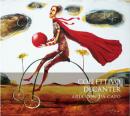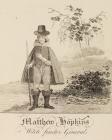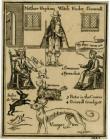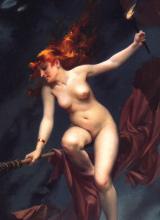Nobody went to heaven, or hell. They just died.
Who's going to think of me, underneath the laughing tree?
With the roots round my feet and the dirt in my mouth,
There’s nothing here to laugh about.
What kind of god loves me, underneath the laughing tree?
What kind of god lets a small chapel rot?
Let's the rafters float out to sea?
Everything dies; everything sinks in the mud,
We prayed hard, there's no answer from God,
All that waste, all the hate, all the blood, all the faith,
And I just lie under the laughing tree.
And if I’d thought a little more, if I stopped and listened at the door,
If I opened up my heart and my tired, lazy eyes,
I might have wings, I might fly.
I want heaven, I want heaven now.
I want heaven, I want heaven now.
All that waste, all the hate, all the blood, all the faith,
I want heaven now.
Who's going to think of me, underneath the laughing tree?
With the roots round my feet and the dirt in my mouth,
There’s nothing here to laugh about.
What kind of god loves me, underneath the laughing tree?
What kind of god lets a small chapel rot?
Let's the rafters float out to sea?
Everything dies; everything sinks in the mud,
We prayed hard, there's no answer from God,
All that waste, all the hate, all the blood, all the faith,
And I just lie under the laughing tree.
And if I’d thought a little more, if I stopped and listened at the door,
If I opened up my heart and my tired, lazy eyes,
I might have wings, I might fly.
I want heaven, I want heaven now.
I want heaven, I want heaven now.
All that waste, all the hate, all the blood, all the faith,
I want heaven now.
Contributed by Dead End - 2013/1/16 - 14:44
×
![]()
Note for non-Italian users: Sorry, though the interface of this website is translated into English, most commentaries and biographies are in Italian and/or in other languages like French, German, Spanish, Russian etc.









Parole di Darren Hayman
Musica di Darren Hayman, insieme a “The Long Parliament”, il gruppo di musicisti che l’accompagnano in questo concept album.
Album “The Violence”
The Violence is a 20-song, double LP chronicling the 17th century Essex Witch Trials during the English Civil Wars.
Between 1644 and 1646, approximately 300 women were executed for witchcraft in the eastern counties of Essex, Suffolk and Norfolk.
The album deals with fear and isolation, the way we use our own terror in times of trouble to lash out at the weak. It’s about how societies persecute otherness and outsiders.
The Violence “it’s about how violence frightens us and how fear just leads to greater violence,” says Hayman.
‘The Violence’ è un concept album di 20 canzoni che raccontano i processi per stregoneria che si tennero nell’Essex inglese nel 17° secolo, durante il periodo delle guerre civili.
Tra il 1644 ed il 1646, nelle contee dell’Essex, del Suffolk e del Norfolk, circa 300 donne furono giustiziate come streghe.
I temi dell’album sono la paura e l’isolamento sociale, il modo in cui nelle epoche di particolare difficoltà gli essere umani usano il terrore sopraffacendo ed eliminando i più deboli tra di loro, perseguitando quelli che appaiono diversi, i marginali, gli estranei/stranieri alle loro comunità.
“Con ‘The Violence’ – dice Darren Hayman – ho voluto spiegare come la violenza ci terrorizzi e come la paura indotta porti soltanto ad una violenza ancora maggiore”
Questa l’introduzione che il suo autore fa del brano:
“An untrue version of the story of Matthew Hopkins recounts that Hopkins himself was accused of being a witch and died as victim of his own justice. Not so, he died an early, though natural, death in 1647. He presumably died believing his soul would fly to heaven.
He was buried in the graveyard of St Mary’s church at Mistley Heath near Manningtree. It took me three visits before I found the broken, crumbled remains of St Mary's. A twisted tree grows though the rubble and appears to be laughing..”
La fine del re portò finalmente una momentanea pace ma – come recita una canzone realista dell’epoca – “A Coffin for King Charles, a Crown for Cromwell and a Pit for the People”, il re Carlo ebbe la sua tomba sontuosa, Cromwell la sua vittoria e al popolo… nient’altro che una fossa! Come al solito…
Il “Witchfinder General” Matthew Hopkins morì ancor prima del re, nel pieno delle prima fase della guerra civile e, anche se i documenti dicono che si spense a 27 anni per “consunzione”, ossia di tubercolosi, non è affatto escluso che tutto l’odio e la morte seminati (in soli due anni quasi 300 furono le donne da lui mandate alla forca come streghe) l’abbiano travolto. Si racconta che lui stesso fu accusato di stregoneria e che fu sottoposto all’“ordalìa dell’acqua” proprio come egli aveva fatto con le sue vittime: galleggiò, e quindi fu impiccato come servo di Satana. Ma questa è solo la leggenda popolare, che in qualche modo restituisce sempre i torti subiti… Fatto sta che il celebre cacciatore di streghe che tanti “servigi” aveva reso alla comunità fu sepolto in una tomba senza nome, tornando così nell’oscurità da dove era arrivato solo due anni prima…
Darren Hayman, il musicista autore di questo concept album, racconta che si recò nel luogo della presunta sepoltura di Hopkins, vicino alla vecchia chiesa di St. Mary a Mistley, sull’estuario dello Stour, non lontano da Manningtree… Tra i ruderi (una nuova chiesa fu costruita poco lontano alla fine del 700) Hayman trovò solo un alberello contorto che dalla forma gli sembrò stesse proprio sghignazzando delle miserie umane…
L’elenco delle canzoni dall’album. Le più significative verranno progressivamente inserite.
1. The Violence
2. Impossible Times
3. How Long Have You Been Frightened For?
4. We Are Not Evil
5. The She-Cavaliers
6. Elizabeth Clarke
7. Vinegar Tom
8. Parliament Joan
9. The Word and the Word Alone
10 I Will Hide Away
11. When the King Enjoys His Own Again
12. Henrietta Maria
13. A Dogge Called Boye
14. Outsiders
15. Arthur Wilson’s Reverie
16. Rebecca West
17. Desire Lines
18. Kill the King
19. A Coffin for King Charles, a Crown for Cromwell and a Pit for the People
20. The Laughing Tree